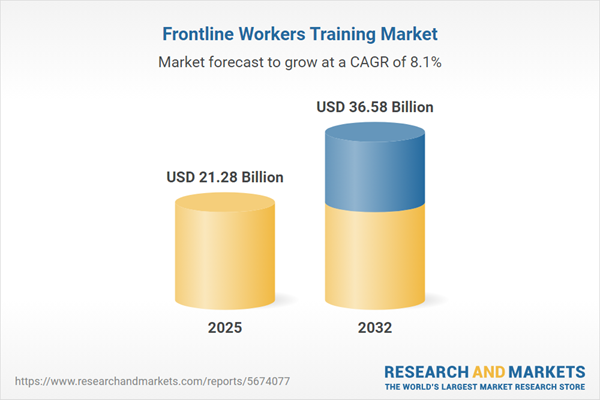Speak directly to the analyst to clarify any post sales queries you may have.
Frontline workforce training solutions are rapidly transforming to support organizations facing increased operational complexity and continuous change. Businesses seeking scalable, technology-driven approaches to learning and compliance are gaining a competitive edge in dynamic, highly regulated sectors by adopting robust, agile workforce training strategies.
Market Snapshot: Frontline Workforce Training Market Overview
The global frontline workforce training market reached a valuation of USD 19.66 billion in 2024, with projections of USD 21.28 billion by 2025 and USD 36.58 billion by 2032. This growth, supported by a compound annual growth rate of 8.06%, is propelled by strong adoption of digital learning management platforms and an increasing shift toward flexible training delivery. Organizations are leveraging scalable, data-driven methodologies to streamline compliance and upskill teams efficiently. As digital-first approaches become standard, technology-enabled training modalities are now favored for their responsiveness and support for evolving workforce needs across all levels of operation.
Scope & Segmentation of the Frontline Workforce Training Market
- Enterprise Size: Large enterprises rely on unified, global learning platforms for consistent training and reporting, while small and midsize businesses benefit from modular systems that manage costs and scale alongside workforce expansion.
- Deployment Models: Cloud-based technologies offer scalability and remote accessibility ideal for distributed teams; on-premise solutions serve organizations with high data sensitivity or stringent compliance management needs.
- Delivery Modes: Blended models—including mobile microlearning and virtual instructor-led options—boost engagement and retention by delivering training flexibly and interactively.
- Training Types: Critical programs address compliance, onboarding, and technical skills; additional modules support leadership growth, workplace safety, and targeted industry capabilities.
- Industry Verticals: Financial services prioritize regulatory learning; manufacturing and logistics focus on safety; healthcare emphasizes rigorous compliance and governance; the public sector seeks efficient regulatory frameworks; retail and hospitality require adaptable content for rapid, varied deployments.
- Regions: Adoption patterns and content needs vary globally. North America and Europe lead in leveraging advanced digital platforms, while Asia-Pacific, the Middle East, and Africa focus on regional workforce regulations and customized content design.
- Companies Analyzed: Microsoft Corporation, Skillsoft Group plc, Cornerstone OnDemand Inc., SAP SE, Adobe Inc., Oracle Corporation, Docebo Inc., Instructure Inc., Udemy Inc., and Blackjack Inc. deliver integration and deployment solutions tailored to broad enterprise training requirements.
Key Takeaways for Strategic Planning
- Modern workforce training technologies enable continuous content updates and rapid deployment, allowing organizations to respond swiftly to changing standards and operational scenarios across business locations.
- AI-powered personalization creates training journeys aligned with different organizational priorities, enhancing employee engagement while supporting overarching business goals.
- Mobile-first microlearning provides frontline staff with timely guidance and reference materials, improving operational agility and consistency, particularly in organizations with widely dispersed teams.
- Integrated compliance training within daily work routines minimizes interruptions and supports ongoing productivity, ensuring adherence to evolving industry standards without disrupting operations.
- Centralized, cloud-based management platforms simplify oversight and support scalability, offering cost-effective solutions for both established multinationals and high-growth businesses seeking streamlined implementation.
- For industries with strict regulatory oversight, secure and configurable learning management systems give organizations precise control over training initiatives and facilitate rigorous governance reporting.
Tariff Impact on Training Technology Supply Chains
Adjustments to U.S. tariffs have increased costs for imported virtual reality and simulation equipment. In response, organizations are accelerating adoption of device-independent and cloud-based training solutions to minimize risk, ensure compliance, and maintain flexibility for teams operating across geographically dispersed environments.
Methodology & Data Sources
The report utilizes extensive secondary research, expert interviews, and frontline employee surveys. Validation is achieved through industry publications, compliance documentation, direct vendor input, and analysis of proprietary corporate resources to ensure recommendations are actionable and reliable for senior decision-makers.
Why This Report Matters
- Enables decision-makers to align training investment with organizational priorities, improving business resilience and supporting readiness for regulatory and operational challenges.
- Offers actionable guidance for deploying digital training platforms in multi-site, compliance-driven environments where coordination and effective oversight are essential.
- Presents relevant benchmarks and analysis tailored to help organizations optimize frontline workforce capability and drive sustainable value across every operational tier.
Conclusion
Investing strategically in frontline workforce training strengthens organizations’ ability to adapt, drive operational effectiveness, and empower teams to meet future demands with agility and confidence.
Additional Product Information:
- Purchase of this report includes 1 year online access with quarterly updates.
- This report can be updated on request. Please contact our Customer Experience team using the Ask a Question widget on our website.
Table of Contents
3. Executive Summary
4. Market Overview
7. Cumulative Impact of Artificial Intelligence 2025
Companies Mentioned
The companies profiled in this Frontline Workers Training market report include:- Microsoft Corporation
- Skillsoft Group plc
- Cornerstone OnDemand, Inc.
- SAP SE
- Adobe Inc.
- Oracle Corporation
- Docebo Inc.
- Instructure, Inc.
- Udemy, Inc.
- Blackboard Inc.
Table Information
| Report Attribute | Details |
|---|---|
| No. of Pages | 180 |
| Published | October 2025 |
| Forecast Period | 2025 - 2032 |
| Estimated Market Value ( USD | $ 21.28 Billion |
| Forecasted Market Value ( USD | $ 36.58 Billion |
| Compound Annual Growth Rate | 8.0% |
| Regions Covered | Global |
| No. of Companies Mentioned | 11 |









